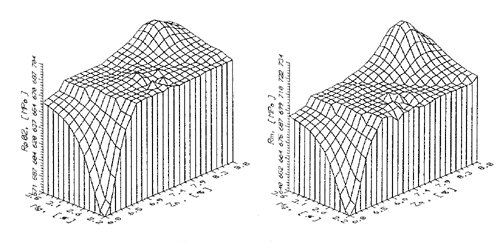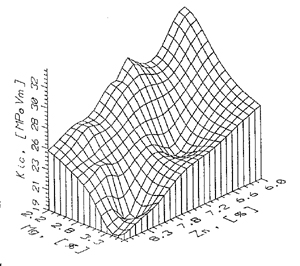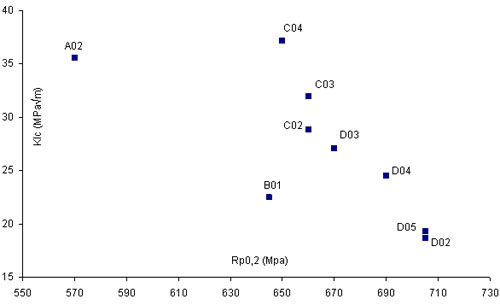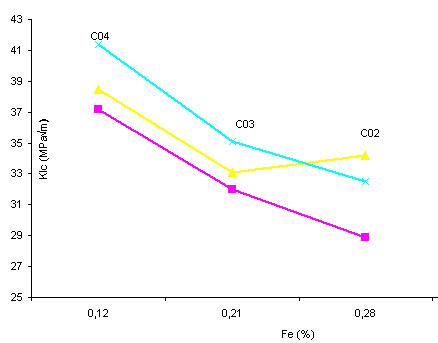Material of complex specified properties, such as strength,
ductility, fracture resistance and stress corrosion cracking
resistance are required for the application in structures
operating under heavy service loadings (like in aircraft and
rocket industry) with prescribed high level of safety margin.
Aluminum alloys, due to convenient strength-to-density ratio,
have found extensive application in heavy-duty structures.
This is the case with AlZnMgCu alloys exhibiting the
highest strength level, but in the same time high level of
susceptibility to fracture and stress corrosion.
Mechanical properties of AlZnMgCu alloys depend on:
- Chemical composition, primarily on total Zn+Mg content
and Zn/Mg ratio
- The presence of Mn, Cr, Zr and
impurities Fe and Si,
- The microstructure as a result of fabrication thermo
mechanical and heat treatment conditions, e.g. on morphology,
distribution and volume portion of intermetallic (IM) phases
and texture.
In the microstructure of AlZnMgCu alloy, the presence of
three types of particles could be expected:
- Large inclusions, 0.1 to 10 mm in diameter, produced
during crystallization (solidification), mainly unsoluble
IM phases rich in Fe and Si; these phases are
weak points regarding the fracture resistance
properties;
- Intermediate particles, rich in Cr, Mn, or
Zr, 0.05 to 0.5 mm in size;
- Small precipitates, with dimensions 0.01 to 0.5 mm, as a
result of solid solution decomposition - thermal
precipitation (ageing).
In order to get a closer insight in metallurgical effects of
hot and cold work, thermo mechanical and heat treatments on
micro structural variations and mechanical properties, many
tests had been performed with the designed alloys. The
morphology and distribution of unsoluble phases sized above
0.6 µm had been investigated by quantitative metallographic
analysis and their influence on fracture resistance was
evaluated.
Tensile properties, ultimate tensile strength Rm and
yield strength RP0.2 are tested on small
size proportional specimens, 8 mm in diameter. Graphic
presentation in the Figure 1 is a result of (here
produced and tested) tests on 200 heats of AlZnMgCu alloys,
heat treated on 460oC for 2 hours, water quenched
and artificial by aged in one step (120oC/24h).
Table 1 - Chemical composition of experimental alloys
|
Alloy
|
Chemical composition (wt %)
|
Impurities
|
|
Design.
|
Zn
|
Mg
|
Cu
|
Mn
|
Cr
|
Zr
|
Fe
|
Si
|
|
A02
|
6.00
|
2.20
|
2.58
|
0.28
|
0.25
|
0.15
|
0.28
|
0.11
|
|
B01
|
7.15
|
3.15
|
1.53
|
0.23
|
0.22
|
0.15
|
0.28
|
0.11
|
|
C02
|
7.38
|
2.21
|
1.44
|
0.29
|
0.24
|
0.15
|
0.28
|
0.11
|
|
C03
|
7.20
|
2.21
|
1.44
|
0.29
|
0.24
|
0.15
|
0.21
|
0.06
|
|
C04
|
7.20
|
2.15
|
1.46
|
0.28
|
0.16
|
0.12
|
0.12
|
0.05
|
|
D02
|
8.30
|
3.30
|
1.63
|
0.24
|
0.23
|
0.15
|
0.28
|
0.15
|
|
D03
|
8.20
|
2.35
|
1.45
|
0.29
|
0.19
|
0.15
|
0.15
|
0.07
|
|
D04
|
8.80
|
3.50
|
1.45
|
0.27
|
0.21
|
0.15
|
0.14
|
0.07
|
From the statistic evaluation following relations could be
derived for Zn and Mg in wt%:
Rm = 461.74 + 20.16 Zn + 33.82 Mg
RP0.2 = 350.81 + 28.40 Zn + 35.10 Mg
Plain strain fracture toughness, KIC, had been
tested according to ASTM E 399 on SE (B) specimens of 20x40
mm cross-section. Fatigue pre-crack was produced on
high-frequency pulsating machine.

a) b)
Figure 1. The effect of Mg and Zn
content on yield strength RP0.2 (a) and ultimate
tensile strength Rm (b) of AlZnMgCu alloys
Figure 2 presents results obtained for several alloys
of different Zn and Mg contents produced
according above given regime. Relation of fracture toughness
with Zn and Mg wt% can be defined in following
form:
KIC = 66.78 - 2.6 Zn - 7.22 Mg

Figure 2. The effect of Mg and Zn content on
fracture toughness KIC of AlZnMgCu alloys
In order to get a closer insight in mechanical properties, in
Figure 3 KIC is presented versus yield
strength for tested alloys. It is clear from Figure 3 that
C0 type alloy series could be accepted (for in detail
analysis) as most promising, regarding strength and fracture
resistance, offering KIC ranged between 28.9 and
41.4 MPa m1/2 for yield strength between 630 and
665 Mpa.

Figure 3. Fracture toughness KIC
related to yield strength RP0.2 for the set of
alloys
However, the selection of best combination of strength and
fracture toughness of AlZnMgCu alloy is also influenced by Fe
content. The effect of Fe content on fracture toughness for
selected AlZnMgCu alloys for the same Zn and
Mg content is presented in Figure 4.

Figure 4. The effect of Fe content on
KIC of AlZnMgCu alloys with same Zn
and Mg content for ageing regimes.
The presence of secondary intermetallic phases in number,
size, volume portion (especially coarse particles, rich in
Fe and Si) has been analyzed on structural
analyzer TAS plus. The analysis of fractured surface after
fracture mechanics test had been performed on a scanning
electron microscope SEM 511 with EDAX 9900.
Performed investigation revealed that the increase of Zn
and Mg content generally increase strength properties
and decrease fracture toughness. Although required strength
(ultimate tensile strength over 650 MPa) had been achieved by
several alloys (B01 type, C02, C03, C04, D02, D03, D04), only
C0 type alloys (~ 7.3% Zn, ~ 2.2% Mg) had offered satisfactory
fracture toughness.
It has also been proved that decreasing Fe content in
alloys (C02 to C04), and corresponding decrease in coarse
intermetallic particles of second phase content result in
increasing fracture resistance. Coarse particles, rich in
Fe and Si, are deformed and fractured during
tests, where as fine regularly distributed intermetallic
phases contribute to ductile behavior. In the last case,
the particles are fractured only seldom.
By comparing obtained results, one can conclude that best
combination of strength and fracture toughness properties
has been achieved by C04 alloy composition, with low
Fe content and corresponding regular distribution of
fine second phase particles.
Two steps precipitation ageing regime (100oC/5h +
160oC/5h) for C04 alloy can be recommended when
highest fracture toughness is required, resulted in slightly
reduced strength parameters compared to one step (129oC/24h)
or alternative investigated two steps (100oC/5h +
130oC/10h) precipitation ageing.
List of Articles - Knowledge Base